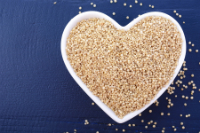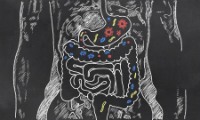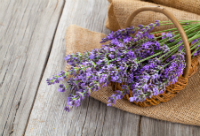JUNE 2017
WHAT’S NEW
THE ADHD – DIET CONNECTION

Two generations ago that was the definition and the belief. Today, we know better. And we know more. Lots more.
WHAT IS ADHD?
THE ROLE OF FOOD IN ADHD
While there are many ways to use “food as medicine,” for some children, food and its additives can actually trigger ADHD. Because diet plays a crucial role in ADHD, it’s important to examine issues such as food intolerance, food allergy, and the additives and chemicals associated with food production. There are various tests to determine both food allergy and intolerance. Your holistic practitioner can advise you about the most appropriate test and then help with interpretation and treatment.
Artificial food colors (AFCs) are widely used by manufacturers to create visually attractive food products. The FDA certifies, for purity and safety, the use of these dyes. However, the amount certified has risen from 12 mg/capita/d in 1950 to 62 mg/capita/d in 2010.
AFCs are not natural to our food system, and surely not to our bodies. These artificial molecules can bond to food or body proteins, which means they can “hide in the body,” avoid detection, and disrupt the immune system. This can have significant immunological consequences that affect gastrointestinal function, auto-immunity and even brain and behavior. For some children, ADHD can be triggered and worsened by synthetic colors, flavors and preservatives.
THE FEINGOLD DIET FOR ADHD
In the 1970’s, Benjamin Feingold, M.D. studied the effect of food chemicals and the role of nutrition in addressing learning disabilities and behavior disorders. He pioneered an elimination diet that removed food dyes from the diets of children. Over the years, Dr. Feingold extended the elimination diet to include petrochemical preservatives BHA and BHT. He has reported rates of 30-70% improvement in children with ADHD, depending on the diagnostic criteria used and adherence to the diet.
Over the decades, studies in Europe and the U.S. have tested the Feingold and similar diets. While research has not established a direct cause-and-effect, the evidence indicates restriction/elimination diets have value and can bring about a change in behavior if properly followed. In response to concerns that children will dislike the Feingold Diet, families can find a wide range of tips for adjusting recipes and food selection, making it easy to incorporate changes and still enjoy favorite foods
In addition to eliminating AFCs, BHA, BHT and food allergens/intolerances, additional support may be needed for some children. This may include educational adjustments, behavior modification or counseling, nutrition supplements, and additional dietary changes. Like any medical or behavioral intervention, treatment benefits will vary based on many factors, such as when a child is diagnosed, the ADHD symptoms present, co-occurrence of other immune or medical conditions, and ability to adhere to dietary changes.
As research continues to explore the relationship between diet, food and behavior, we anticipate that many more children – and adults – with ADHD will be helped by the medicinal power of food.
If your family struggles with the consequences of ADHD, ask your doctor or holistic practitioner for suggestions and guidance. You do not need to walk this path alone.
FOOD FOR THOUGHT. . .
“A man’s health can be judged by which he takes two at a time – pills or stairs.” – Joan Welsh
QUINOA SUPER GRAIN SUPER FOOD

While quinoa is actually a seed, it’s prepared and eaten much like rice and other grains. All three types of quinoa — red, black, and white — are essentially equivalent in their nutritional profile and notable health benefits:
Protein-rich Grain. Quinoa contains all nine essential amino acids, the building blocks of muscle tissue and catalysts important to many physiological processes. As a protein-rich grain (8 g. per serving), quinoa is a terrific option for food combining for people following a vegan, vegetarian or gluten-free diet.
It’s “fibered” up! There’s nearly twice as much fiber in quinoa compared to most other grains. Fiber plays a role in reducing risk factors for heart disease, gastrointestinal disorders, diabetes, and cancer.
Ironman Loves Quinoa. It’s a bit of a fib, but go ahead and tell your kids that Ironman loves quinoa, precisely because it contains iron, which keeps our red blood cells healthy and carries oxygen throughout the body.
Energy Boost. This may be another reason why Ironman loves quinoa: It’s high in vitamin B2 (riboflavin), which improves energy metabolism within the brain and muscles cells. It’s also high in manganese, an antioxidant that helps protect cells from damage.
Quinoa is such an easy to grow, tasty super-food, even NASA scientists have been studying it as a possible crop to be grown in outer space. Be sure to give it a try.
RECIPE: QUINOA PUDDING (DAIRY FREE)

Lavender has a wide range of “floral notes” that can be achieved depending on the intensity of the concentration. It’s available as a tincture, infusion, extract and, as noted, an essential oil alone or in combination with other herbs used for relaxation. Dried lavender and its derivatives are used in bath salts, sachets, eye pillows, and potpourris. Lavender, in herb form, may also be used in herbal beverages and teas.
PROBIOTICS: MANAGE FOOD ALLERGIES AND ENHANCE IMMUNITY

- Boost immunity by enhancing the production of antibodies
- Support the synthesis of vitamins and increase bioavailability of nutrients
- Protect the GI tract from disease-causing bacteria
- Alleviate symptoms of GI illness (diarrhea, constipation, IBS)
- Reduce seasonal and food allergies
Regarding dietary allergens and immunity, scientists believe probiotics achieve their health benefits by stimulating the immune response to increase the secretion of immunoglobulin-A (IgA), which boosts the body’s response to food allergens. Elevated IgA may also decrease pathogens in the gut, which improves the balance of GI flora. Probiotics elevate “natural killer cells” that gobble up disease-generating “invader cells” and may protect nutrients that would otherwise be destroyed by pathogens.
Probiotic supplements come in liquid, powder, chewable and capsule form, ranging from one million to several billion live organisms. Most are sold refrigerated. Keep probiotics properly stored so as not to kill the live, healthy bacteria. With new probiotic technology, there are many reputable brands now that do not require you to store your probiotics in the fridge, which makes them great for traveling.
Even though probiotics have well documented health benefits, they are not a panacea. Probiotics are most effective when you are supporting your health with a balanced organic whole foods diet. Your health practitioner can determine the best probiotic strains and dosage and any other supplements suited for your specific health concerns.
At Indigo Integrative Health Clinic we have some of the best high quality probiotics on the market today.
RELAX WITH LAVENDER (Lavandula angustifolia)

Today, lavender essential oil is used in aromatherapy to help balance and soothe mental and emotional stress. While, lavender initially feels “reviving” to the senses, within moments it has a calming and restorative effect. In botanical medicine, lavender is used in treatment for anxiety, insomnia, fatigue, tension headache, and mild depression. For individuals with ADHD or Autism Spectrum Disorders, lavender is safe to use as part of a relaxation routine. It’s one of the few essential oils that may be applied directly to the skin undiluted or in combination with other oils for massage and bathing.
Lavender has a wide range of “floral notes” that can be achieved depending on the intensity of the concentration. It’s available as a tincture, infusion, extract and, as noted, an essential oil alone or in combination with other herbs used for relaxation. Dried lavender and its derivatives are used in bath salts, sachets, eye pillows, and potpourris. Lavender, in herb form, may also be used in herbal beverages and teas.
FOOD ALLERGIES: TESTING HOW THE BODY RESPONDS

A food sensitivity happens gradually. Triggers include: stress, infection, poor eating habits (e.g., over-consumption of foods with additives, preservatives), or foods exposed to toxins such as pesticides and pollutants. Food sensitivity can lead to chronic health problems, including ADHD, digestive disorders, and persistent infection.
The immune system triggers the body’s response to a food allergen. Protein molecules called immunoglobulin (Ig) circulate in the body via white blood cells. Immunoglobulin (a.k.a. antibodies), very specifically recognize and bind to bacteria, fungus, viruses, or other foreign substances so the immune system can destroy them. Think of immunoglobulins as goblins gobbling up invaders in the body. Once an antibody is produced against a specific invader, the next time it enters the body, the immune system “remembers” it and produces more of the same antibodies to destroy the invader.
If the root cause of a medical condition can be identified as a food allergy or sensitivity, we can use “food as medicine” to correct the imbalance. To do this, a blood test of Ig activity in response to different allergens is done.
TESTING FOR FOOD ALLERGIES
There are several Ig types that have different yet synergistic roles in the immune system.
IgE antibodies cause the body to react, at times violently and immediately, to things such as pollen, fungus, insect stings, medications, milk and other foods. IgE levels are often highest in people with allergies, including food allergy. An IgE test covers the major food allergens that produce immediate reactions in the body, such as nut, egg, cow’s milk, shellfish, and soy.
IgG antibodies fight bacterial and viral infection. Found in all body fluids, this antibody is typically associated with food sensitivity.
IgA antibodies protect body surfaces exposed to outside foreign substances. It’s abundant in mucus found throughout the body, including the gut; a deficiency in IgA could be tied to adverse responses to food.
The IgE test can be combined with IgA and IgG tests for a more comprehensive test of nearly 200 allergens including meat, dairy, starches and grains, mold and other environmental substances.
There are many ways your health practitioner can approach testing and help you make dietary modifications based on test results, current health concerns, and lifestyle factors. It’s not just about eliminating a food. It’s about looking at the whole picture of your health and the role food plays as both nourishment and medicine for you and your family members.
Read more about the Food Sensitivity Panel we offer at Indigo Integrative Health Clinic.
REFERENCES
THE ADHD – DIET CONNECTION
- Lyon, M. & Murray, T., “ADHD.”as cited in Pizzorno, J. E. & Murray, M.T. Textbook of Natural Medicine: 4th Ed. (2013) Chapter 150, p. 1252-1259.
- Verlaet AAJ, Noriega DB, et al., “Nutrition, immunological mechanisms and dietary immunomodulation in ADHD.” European Child & Adolescent Psychiatry (2014 Jul) 23:7, p. 519-29. doi: 10.1007/s00787-014-0522-2.
- Vojdani & Vojdani, “Immune Reactivity to Food Coloring.” Alternative Therapies in Health and Medicine (2011) 21 Suppl, p. 1:52-62. h
- Stevens, L.J. et al., “Amounts of artificial food dyes and added sugars in foods and sweets commonly consumed by children.” Clinical Pediatrics (2014 Apr 24), p. 1-13. Accessed 9 April 2017.
- Nigg, Joel T., & Holton, K. “Restriction and Elimination Diets in ADHD Treatment.” Child and adolescent psychiatric clinics of North America 23.4 (2014), p. 937–953. PMC. Accessed 9 April 2017.
- Feingold.org. Feingold Diet List of Research Studies. Accessed 9 April 2017.
- Bell, C.C. “A Comparison of Daily Consumption of Arti cial Dye-containing Foods by American Children and Adults.” (2013, March) Master’s Thesis Eastern Michigan University. Accessed 12 April 2017.
QUINOA SUPER GRAIN SUPER FOOD
- Gunnars, K. “11 Proven Health Benefits of Quinoa.” AuthorityNutrition.com Accessed 7 April 2017.
- WorldsHealthiestFoods.com. “What’s New and Beneficial about Quinoa?” Accessed 7 April 207.
- Schlick, G. & Bubenheim, D.L., “NASA Technical Paper 3422: Quinoa: An Emerging Crop with Potential for CELSS.” Accessed 7 April 2017.
PROBIOTICS: MANAGE FOOD ALLERGIES AND ENHANCE IMMUNITY
- Pizzorno, J. E. & Murray, M.T. Textbook of Natural Medicine: 4th Ed. (2013). Content cited from the following chapters and pages:
“Chronic Candidiasis” p. 466
“Immune Support” (Chapter 56, p 516 – 523)
“Probiotics” (Chapter 116, p. 979-993)
“ADHD” (Chapter 150, p. 1252-1258) - Laitinen K, Isolauri E. “Management of food allergy: vitamins, fatty acids or probiotics?” Eur J Gastroenterol Hepatol. (2005),17:1305-1311. PMID: 16292082.
- Kligler B, Hanaway P, Cohrssen A. “Probiotics In Children.” Pediatr Clin North Am. (2007), 54:949-967:xi. PMID: 18061785 DOI: 10.1016/j.pcl.2007.10.002
- Verna EC, Lucak S. “Use of probiotics in gastrointestinal disorders: what to recommend?” Therap Adv Gastroenterol. (2010) 3:307-319.
- Macfarlane GT, Cummings JH. “Probiotics and prebiotics: can regulating the activities of the intestinal bacteria benefit health.” BMJ. (1999) 318:999-1003. Accessed 12 April 2017.
- Kiani, L., Cambridge Scientific Abstracts- Discovery Guide. “Bugs in our Gut: How Probiotics Keep Us Healthy.” (2006). Accessed 12 April 2017.
- Mayo Clinic. Probiotics. Accessed 12 April 2017.
RELAX WITH LAVENDER
- Mars, B. & Fiedler, C., The Home Reference to Holistic Health and Healing. Appendix A: Lavender. (2015) 191. Fair Winds Press: Boston, MA.
- Curtis, S. Essential Oils. (2014) 82-83. Winter Press: London.
- University of Maryland Medical Center Complementary and Alternative Medicine Guide Onlien. “Lavender.” Accessed April 7, 2017.
- Ernst E., The Desktop Guide to Complementary and Alternative Medicine: An Evidence-Based Approach. (2001) 130-132. Edinburgh: Mosby.
- Howard S, Hughes BM. “Expectancies, not aroma, explain impact of lavender aromatherapy on psychophysiological indices of relaxation in young healthy women. “Br J Health Psychol. (2008 Nov 13. Pt 4):603-17.
- Williams TI. “Evaluating effects of aromatherapy massage on sleep in children with autism: a pilot study.”Evid Based Complement Alternat Med. 2006;3(3):373-7.
- Koulivand, Peir Hossein, Maryam Khaleghi Ghadiri, and Ali Gorji. “Lavender and the Nervous System.”Evidence-based Complementary and Alternative Medicine : eCAM 2013 (2013): 681304. PMC. Accessed: 7 Apr. 2017:
- Levy, Susan E., and Susan L. Hyman. “‘Complementary and Alternative Medicine Treatments for Children with Autism Spectrum Disorders.’” Child and adolescent psychiatric clinics of North America 17.4 (2008): 803–ix. Accessed 7 Apr. 2017.
FOOD ALLERGIES: TESTING HOW THE BODY RESPONDS
- Hosdson, W., “Food Allergies.”as cited in Pizzorno, J. E. & Murray, M.T. Textbook of Natural Medicine: 4th Ed. (2013) Chapter 15, p. 131-139.
- ThernoFisher Scientific. “Introduction to Immunoglobulins.” Accessed 13 April 2017.
- FoodsMatter.com. “Food Allergy and IgA Deficiency.” Accessed 13 April 2017.
- Alletess Medical Labs Patient Information on Food Allergy Testing. (2016)
- Vojdani, Aristo. “Detection of IgE, IgG, IgA and IgM Antibodies against Raw and Processed Food Antigens.” Nutrition & Metabolism 6 (2009): 22. PMC. Web. 13 Apr. 2017.
GUIDING PRINCIPLES

First Do not Harm

Identify and Treat the cause

Healing Power of Nature

Doctor as Teachers

Treat the Whole

Prevention is best Medicine
Follow us on instagram
BLOG
Become an educated consumer with our Indigo Blogs and prevent dis-ease.
Our Doctors have been featured in:









